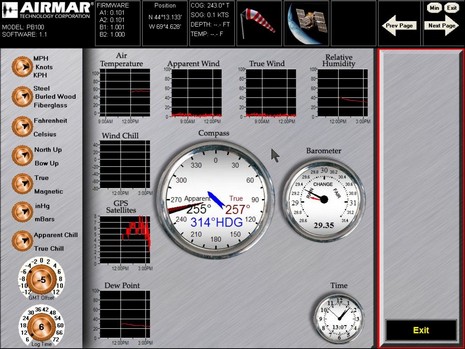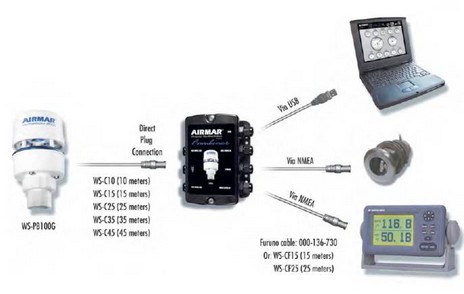Airmar Weather Station, really here and really works

I’ve been posting on Panbo for almost exactly a year now, and one of my first entries was about the sailing version of Airmar’s WeatherStation. While I’m sorry to report that that product still does not exist, the powerboat version does and I’ve been testing one. Above, and bigger here, is a screenshot of the PC software that comes with the ultrasonic (no moving parts!) sensor. This particular screen shows the controls available (left) and also what data can be graphed over time. Clicking on any of those graphs switches it to the gauge-style real-time reading. The software is very easy to use but needs some work; for instance, the wind speeds are graphed to a 0–100 knot scale, which means that low speeds hardly show any differentiation. And wind direction history is not kept, which is something that must be fixed for the coming sailboat version (which won’t have a GPS, but will have an inclinometer supposedly able to correct the wind sensor for heel).
But I quibble. There are a lot of neat ways to use the WeatherStation, well illustrated in its latest PDF brochure. I have most of the setup below working (I just haven’t installed the “Smart” depth/speed/temp sensor yet), and it’s a powerful little network. A PC charting program like CE easily collects wind/GPS/heading/air temp coming out of the optional combiner via USB at 57,600 baud, plus the Furuno RD30 (a very handy device) provides alternate data display, and there’s room to run more NMEA 0183 devices into or out of the combiner. Nice detail: according to the WeatherStation manual (another PDF) the combiner favors alternate GPS or heading inputs over what’s built into the unit. I think that means that the built-in sensors can serve as automatic back ups. Nice!













Cute, but I fail to see how this produces better data than B&G or even Raymarine. B&G in particular has spent years calibrating their wind instruments to address updraft from the sails, etc.
The barometer, temp and humidity are pretty simple to get from a saloon mounted instrument, I don’t see the advantage of gathering that on the top of the mast.
This may be why they’re pursuing the powerboat market.
So, can this system replace the outrageously expensive wind indicators that the other vendors sell? And put that info on a bus that can be read by all of the various displays and computers and autopilots?
Also, how much?
I see no reason they can’t incorporate AIS with this! 🙂
Ralph, Yes this sensor can replace a standard cup’n’vane system, though at about $1,000 it’s not cheap (then again it offers a lot more data). And it can talk to multiple displays within the limits of NMEA 0183. Airmar plans an NMEA 2000 version of the WeatherStation and Maretron will soon ship a 2000 ultrasonic wind sensor. I think ultrasonics offers the potential for greater precision than standard sensors but I don’t know if either of these manufacturers has achieved that.
Has anyone looked at or used the Maretron DSM200 display unit? It looks similar in function to the Furuno RD30, and being newer has higher resolution and thus prettier displays. I currently have a single Raymarine ST290 Graphic display (with room for 1 more this size) and the price of the Maretron looks a lot more attactive than the Raymarine, plus it has some nifty display modes (guages, wind, GPS status) that the Raymarine can’t touch. To be fair I really like the Raymarine docking display that overlays rudder, wind, tides, heading and speed. If this product works as advertized, I could see if filling my remaining display position.
I forgot to add the link to some screen shots and product information:
http://www.maretron.com/products/screenshots.php
http://www.maretron.com/products/dsm200.php
Dave,
I have an early version of this display and it’s not very bright or contrasty, but I do understand that it has been improved. My experience with the Maretron sensors is that they do work as advertized, but do you realize that you’re getting into a NMEA 2000 network here? The ST290 is actually one of the first NMEA 2000 certified devices (Raymarine calls it SeaTalk2), so it should be able to communicate with the Maretron display and network. Say, do you have a picture of the ST290’s docking display? I too think that’s a great (and under appreciated) feature.
There is a screenshot of the docking display in chapter 2 of the ST290 manual which is conviently available from Raymarine in PDF format:
http://www.raymarine.com/raymarine/SubmittedFiles/ST290_sect_02_iss2.pdf
Or for those who just want to see the screenshot, here is a clip from the manual:
http://www.davebrennan.com/st290-docking.jpg